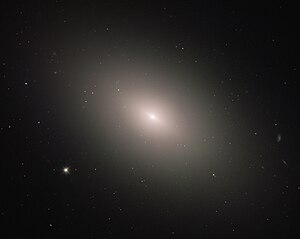Messier 59
| Galaxy Messier 59 |
|
|---|---|

|
|
| Image taken with the Hubble Space Telescope | |
| AladinLite | |
| Constellation | Virgin |
|
Position equinox : J2000.0 , epoch : J2000.0 |
|
| Right ascension | 12 h 42 m 02.2 s |
| declination | + 11 ° 38 ′ 49 ″ |
| Appearance | |
| Morphological type | E5 |
| Brightness (visual) | 9.7 likes |
| Brightness (B-band) | 10.7 mag |
| Angular expansion | 5 ′, 4 × 3 ′, 7 |
| Position angle | 165 ° |
| Surface brightness | 13.0 mag / arcmin² |
| Physical data | |
| Affiliation | Virgo Galaxy Clusters |
| Redshift | +0.001558 ± 0.000017 |
| Radial velocity | +467 ± 5 km / s |
|
Stroke distance v rad / H 0 |
(19 ± 1) x 10 6 ly (5.72 ± 0.41) Mpc |
| history | |
| discovery | Johann Gottfried Koehler |
| Discovery date | April 11, 1779 |
| Catalog names | |
| M 59 • NGC 4621 • UGC 7858 • PGC 42628 • CGCG 70-223 • MCG + 02-32-183 • 2MASX J12420232 + 1138489 • VCC 1903 • GC 3155 • h 1386 • | |
Messier 59 (also known as NGC 4621) is a 9.7 mag bright elliptical galaxy with an area of 5 ′, 4 × 3 ′, 7 in the constellation Virgo .
M59 is one of the larger elliptical galaxies of the Virgo galaxy cluster , but significantly smaller than the giants M49 , M60 and M87 . The globular cluster system comprises almost 2,000 globular clusters, i.e. about ten times the number in our Milky Way system , but only a good tenth of the number in the system of M87. The type of this galaxy in the Hubble sequence is E5, which means that the galaxy is quite flattened.
Messier 59 was discovered on April 11, 1779 by the German astronomer Johann Gottfried Köhler .
Web links
Commons : Messier 59 - collection of images, videos and audio files
- M59 at SEDS
- Spektrum.de : Amateur recordings [1]


